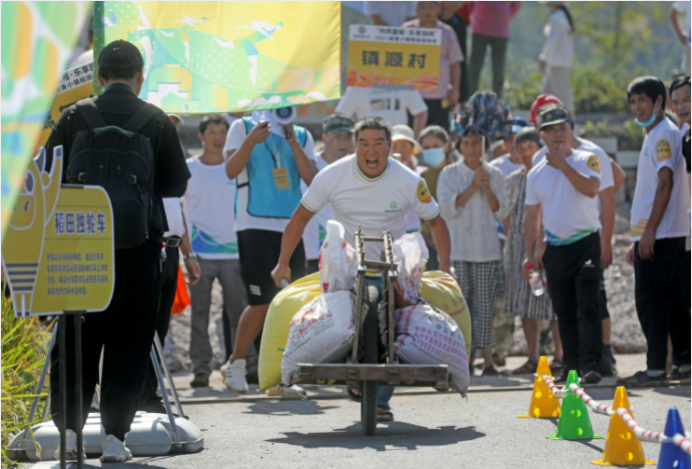
A farmer hauls grain with a wheelbarrow during a competition in Jiande, Zhejiang province, on Wednesday. The city organized fun games including rice reaping and tug-of-war in the fields to celebrate the Farmers' Harvest Festival. LIN YUNLONG/FOR CHINA DAILY
A series of events ranging from art performances and farmers' sports meetings to calligraphy and painting exhibitions are being held across the country to mark the fourth Chinese Farmers' Harvest Festival on Thursday ahead of what is predicted to be a bumper autumn harvest.
Events kicked off as early as last week in Yuncheng, Shanxi province. The city government said its celebrations include a livestreaming session aimed at promoting local farm produce and an exhibition of fertilizers, high-yield seeds and other agricultural materials.
In Heihe, Heilongjiang province, the festivities were combined with local traditions of the ethnic Daur people-such as dancing around bonfires-in a bid to boost local tourism.
"Over the past three years, the festival has gradually become popular among hundreds of millions of farmers and now serves as a symbol of China's agricultural civilization and a window to vitalized rural regions," People's Daily said on Wednesday.
Created in 2018, the festival is held each year on the autumn equinox during the September harvest season and became a statutory event this year.
Figures from the Ministry of Agriculture and Rural Affairs showed the autumn grain growing area is about 86 million hectares this year and is bracing for a bumper harvest.
Autumn grain crops account for the bulk of the year's grain production in China.

Farmers display crabs just harvested from Yangcheng Lake in Suzhou, Jiangsu province, on Wednesday, as this year's harvest season for the highly sought-after delicacy begins. CHINA DAILY
To ensure a bumper harvest, the central government allocated 20 billion yuan ($3.1 billion) in subsidies to farmers amid a hike in the prices of seeds and fertilizers in spring.
Central and local authorities also spent 3 billion yuan on the control of wheat pests and diseases to secure grain production and managed to cap the damage rate below 5 percent.
People's Daily said the policies incentivized Chinese farmers to work harder and help stabilize annual grain output at around 650 million metric tons.
After announcing the elimination of absolute poverty earlier this year, China ramped up efforts to further vitalize the countryside through measures such as protecting farmland, boosting rural incomes and preserving ecosystems.
In Jilin province, where authorities are working to restore degraded black soil farmland, about one-third of grain growing areas this year have been earmarked for conservation agriculture, a farming system that aims to cause minimum soil disturbance and maintain the soil cover.
The provincial government said the percentage of conservation agriculture is expected to rise further, reaching about 70 percent by 2025.
Official figures showed that the disposable income of rural residents increased by more than 14 percent year-on-year in the first half of the year to reach 9,248 yuan.
China launched a national campaign in 2015 to curb the use of fertilizers and pesticides, and People's Daily said their use has decreased for four consecutive years.
In recent years, central authorities have also been ramping up construction of "high-standard farmland" for large mechanical farming, which officials said is more resilient to droughts and floods because of its irrigation and drainage systems.
Vice-Minister of Agriculture and Rural Affairs Zhang Taolin told a news conference in Beijing last week that such grain growing areas had reached 53.3 million hectares as of last year and will surpass 80 million hectares by 2030.
They will increase yields by 10 to 20 percent and cut costs by 7,500 yuan a hectare, he said.
Meanwhile, China has placed greater emphasis on curbing food waste amid disruptions caused by the COVID-19 pandemic and extreme weather.
As part of the effort, China enacted an Anti-Food Waste Law in April and sought to bolster international cooperation on curbing food losses during production.

